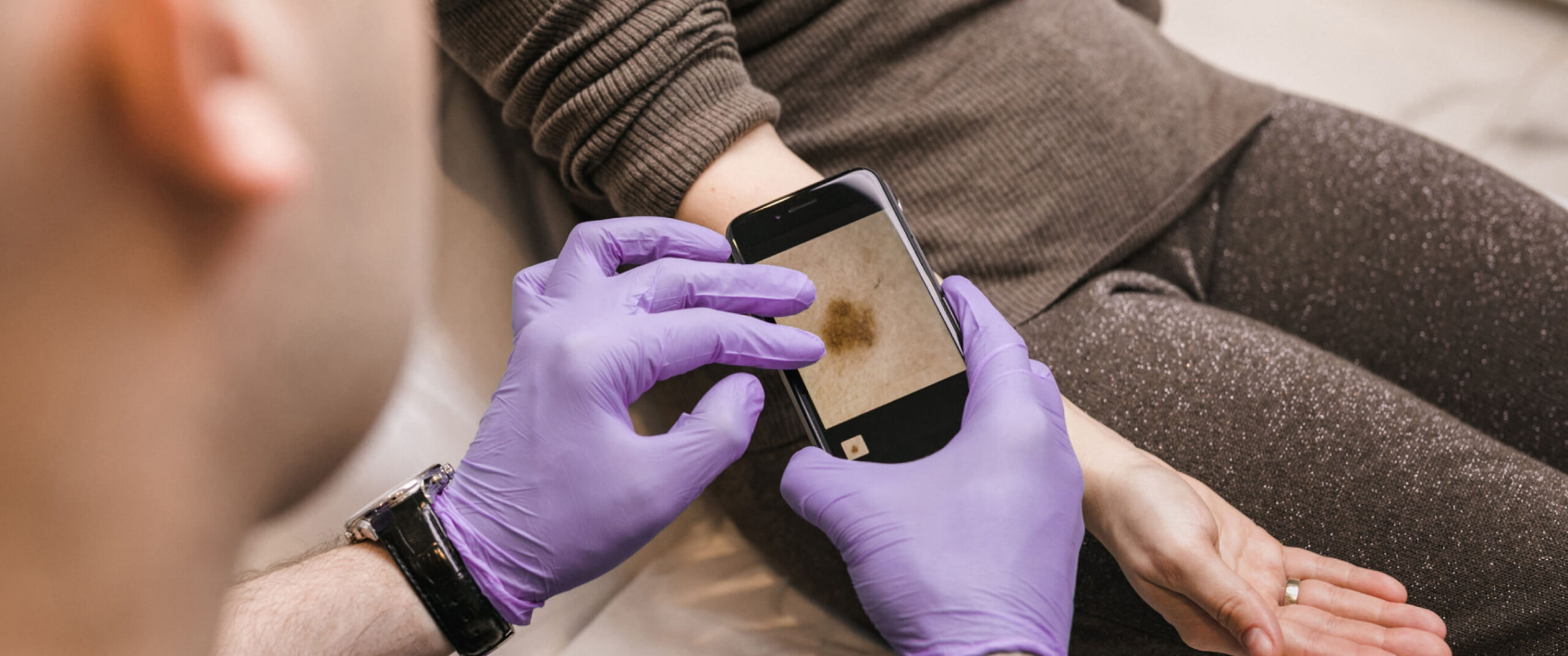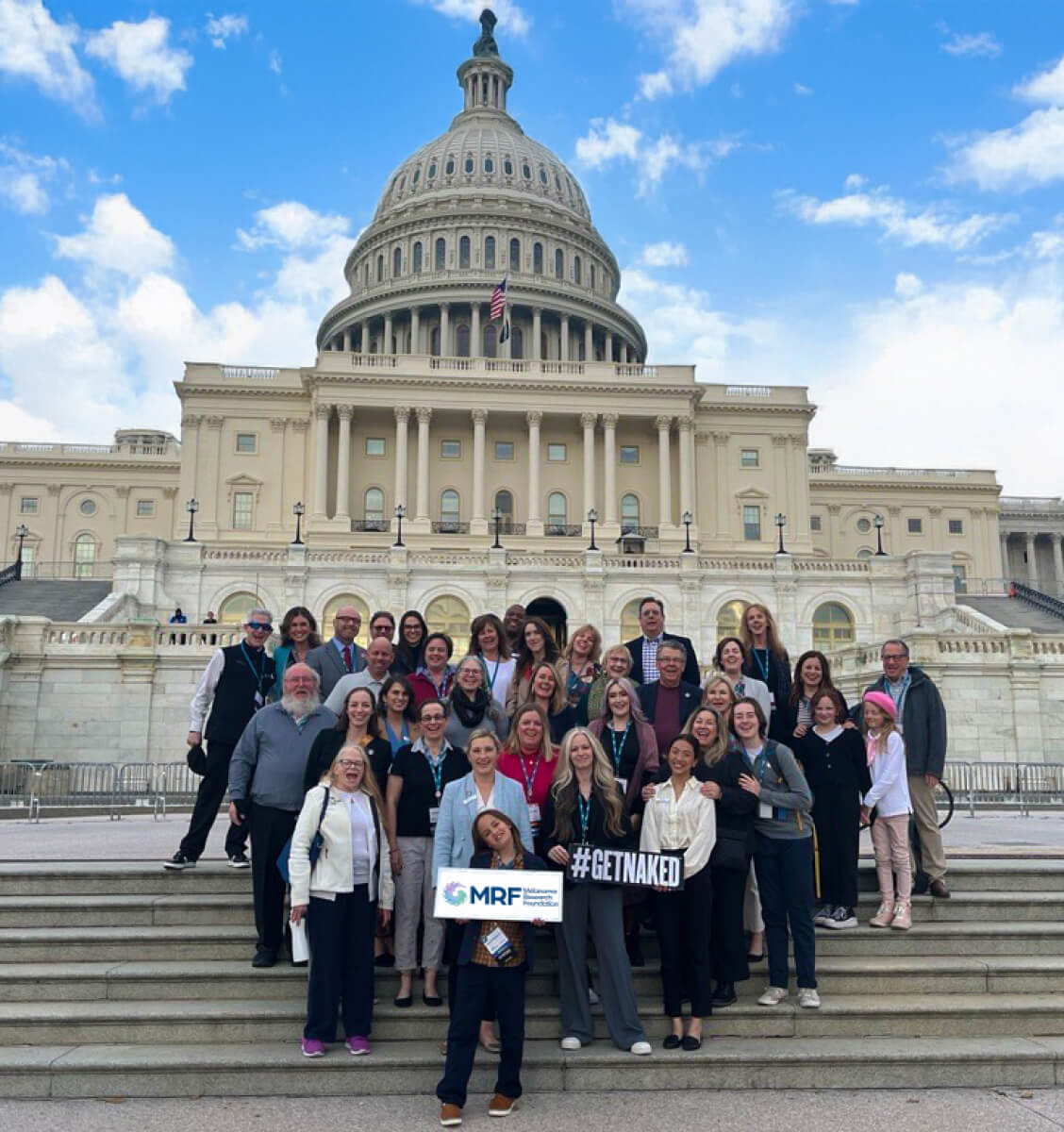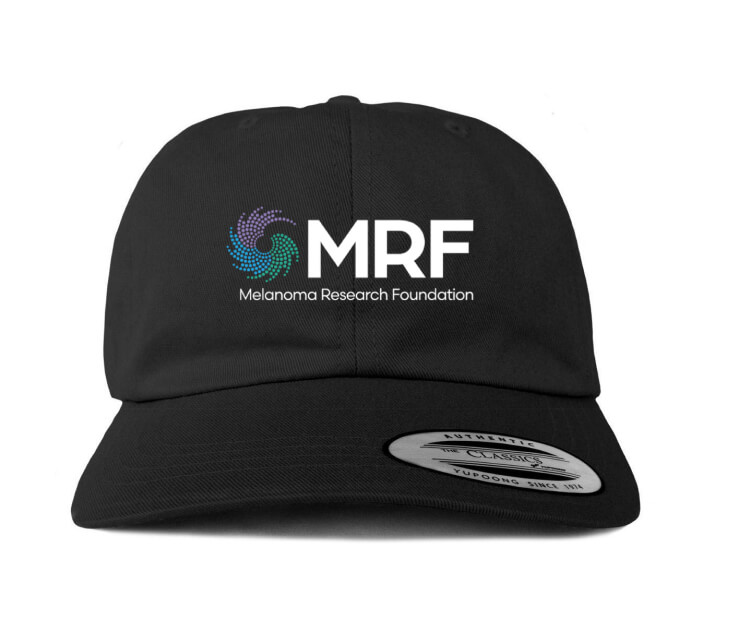January 27, 2025
Our Impact
The Advocacy Program’s primary goal is to transform melanoma care by engaging all stakeholders to drive policy change. Whether you are a patient, caregiver, survivor, healthcare professional or partner, YOU play a critical role in the advancement of better outcomes for over one million Americans living with melanoma and their loved ones.
Prevention
Research suggests that nearly 93% of cutaneous melanomas are related to UV exposure. Therefore, most, but not all, melanomas are thought to be preventable. In fact, just ONE blistering sunburn can double someone’s chances of developing melanoma and using tanning beds before age 30 increases one’s risk of skin cancer by an astounding 75%.
The MRF works on the federal and state levels to support policies that help prevent melanoma in the first place. With our advocates, the MRF has championed state and federal initiatives to prohibit anyone under the age of 18 from using indoor tanning devices, worked to increase accessibility of sunscreen in schools without the need for a doctor’s note or prescription, supported the Center for Disease Control’s (CDC) Skin Cancer Prevention Activities, and ensure that cost is not a barrier to accessing life-saving skin cancer screenings.

Sunscreen Filter Approval
In 2014, Congress passed the bipartisan Sunscreen Innovation Act (SIA) in an effort to bring more sunscreen filters to the American people. During the negotiations of the SIA, the Food and Drug Administration (FDA) indicated that new products would enter the market as soon as six months after passage. However, 10 years later no new sunscreen active ingredients have been approved in the United States by the FDA. Importantly, from the date of enactment of the SIA in 2014 until 2022 (the most recent year data is available), there were approximately 775,000 new cases of skin cancer, and 75,000 people have died.
Together with our partners and advocates, the MRF has urged both Congress and the FDA to remove barriers to sunscreen access. The best sunscreen is the one that you will use, and that means that we need sunscreens that fit a variety of skin tones and conditions.

No Co-Pay for Skin Cancer Screenings
Skin cancer screenings are not considered an essential health benefit under the Affordable Care Act (ACA) and are thus subject to cost-sharing – meaning patients must pay for their care – in the form of deductibles, co-pays, or co-insurance in order to be screened. With No Copay state-based legislation, the cost of receiving a skin cancer screening isn’t passed along to the patient for eligible health insurance plans regulated by the state. Currently, Illinois and Florida have passed No Copay legislation for skin cancer screenings.
Interested in working to get No Copay legislation enacted in your state? Please email advocacy@melanoma.org.

Ban the Tan
The U.S. Department of Health and Human Services (HHS) and the World Health Organization (WHO) International Agency of Research on Cancer panel declared ultraviolet radiation from the sun and artificial sources such as tanning beds and sunlamps to be a known carcinogens (cancer-causing substance). 1
Research indicates a 75% increase in the risk of melanoma in those who have been exposed to UV radiation from indoor tanning, and the risk increases with each use. Each year, more than 419,000 cases of skin cancer, including melanoma, are linked to indoor tanning in the U.S. alone. Despite these significant risks, nearly 7.5 million people in the United States use indoor tanning devices each year.
Together with our partners in skin cancer prevention and concerned advocates, the MRF has been at the forefront of state and federal work to keep children out of tanning beds. To date, 44 states and the District of Columbia restrict access to indoor tanning equipment either through banning their use by minors or requiring parental consent.

BECOME AN ADVOCATE
Access
Telehealth
The Melanoma Research Foundation (MRF) represents patients with both common and rare types of melanoma and strives to advocate effectively for both populations while honoring the unique needs of each patient community. Of particular concern to melanoma patients is their ability to receive or continue receiving care from healthcare specialists not located within their immediate geographic area as the number of providers who specialize in rare melanomas, such as ocular or mucosal melanoma, is small and concentrated in large academic medical centers.
However, even cutaneous melanoma patients face challenges accessing dermatologists, particularly due to workforce shortage issues within that field of medicine. According to data from our ocular melanoma VISION Registry, 40% of ocular melanoma patients travelled over 50 miles to receive an official ocular melanoma diagnosis, 60% of ocular melanoma patients traveled over 50 miles to receive treatment, and 50% of ocular melanoma patients traveled over 500 miles to receive treatment for metastatic disease. As a result, the MRF encourages Congress to consider the solutions that telehealth flexibilities provide with regards to accessing teledermatology or specialized oncologists capable of providing innovative care for the rare disease community from the privacy and comfort of a patient’s home when doing so is appropriate for that patient’s care.
The MRF encourages Congress to consider the ways that failure to implement permanent telehealth flexibilities would disrupt ongoing patient care.
Utilization Management
In seeking treatment and other medical services, most patients are confronted with the burden of utilization management. Utilization managements tools, such as prior authorization, are leveraged by health plans to control spending and improve the quality of patient care. Instead, these programs have ostensibly become a way for insurance companies to delay the delivery of healthcare services or deny treatments with little transparency.
Prior authorization ostensibly enables health plans to reduce unnecessary care by requiring healthcare providers (HCPs) to get approval for medical services. In most cases, it is a cumbersome process of days-long negotiations between physicians and insurance companies – during at which time patients could be receiving what may be time sensitive, lifesaving care. Not only is it the primary administrative burden identified by HCPs, but nearly 3 out of 4 enrollees of Medicare Advantage are continuously subjected to unnecessary delays.
The MRF supports utilization management reform and prior authorization reform.
Biomarker Testing
Biomarker testing has proven to be a critical tool in the understanding of and pivoting towards precision medicine, significantly improving patient outcomes by offering a detailed look at proteins or gene mutations found in cancerous cells that can inform treatment options and improve outcomes.
While we know biomarker testing provides critical information for melanoma patients as they navigate care, large gaps in insurance coverage prevent melanoma patients nationwide from accessing the benefits of precision medicine. Over 20 states do not provide partial or comprehensive insurance coverage to cover costs. Specifically, many payers in the state-regulated, fully-insured commercial market are not covering biomarker testing consistent with clinical guideline recommendations.
The MRF supports state legislation that expands insurance coverage of comprehensive biomarker testing for all melanoma patients.
Clinical Trial Access
Clinical trials are an important option in the treatment plans of thousands of Americans facing life-threatening diseases. In addition to being the best clinical option for many, clinical trials collect valuable data in the development of therapeutics that can be used to improve patient care for people with cancers like melanoma, among other illnesses.
Despite the advantages of clinical trials to both patient care and the medical community, access to these trials is limited. The Clinical Treatment Act, which directed Medicaid to cover direct costs associated with participation in a clinical trial, passed at the end of 2020 as part of the Consolidated Appropriations Act and went into effect on January 1, 2022. However, indirect costs such as travel expenses and childcare remain a barrier to accessing clinical trials. As a result, hundreds of thousands of Americans cannot afford to even consider clinical trials as a possibility in their treatment plan.
Federal Funding
The MRF continues to advocate for increased research funding in order to one day achieve a world without melanoma. The United States federal government is the largest funder of cancer research in the world and advanced innovation in melanoma prevention, detection and treatment is only possible with continued investment in high-quality research.
Defense-Funded Melanoma Research
From Fiscal Years (FY) 2009 to 2018, melanoma researchers were eligible to receive Defense funding through the Peer Reviewed Cancer Research Program (PRCRP). Over that time period, the Department of Defense through the PRCRP funded $52.5 million in melanoma research.
In September 2018, MRF Advocates rallied to make melanoma a national priority and they successfully advocated for dedicated melanoma research funding in the FY2019 Defense appropriations bill. Congress passed and the President signed into law the Fiscal 2019 Defense Appropriations bill, H.R. 6157, which included a separate line item for the Defense-funded Melanoma Research Program (MRP) and provided a $10 million appropriation for the program. This $10 million line item was the first time that melanoma research received dedicated Department of Defense (DOD) funding and represented a historic moment for the melanoma community.
Warfighters have unique exposures as a result of their service that increase their risk of melanoma. That’s why the MRF is committed to growing the amount of funding received by the MRP. From the initial $10 million in FY2019, the program has now grown to $40 million in federal funding thanks to the continued, steady work of our dedicated advocates.
National Institutes of Health (NIH) and National Cancer Institute (NCI) Funding
Take Action
A vast amount of melanoma cancer research comes from the NCI within the NIH — the primary federal agency charged with biomedical research.
Clinical advances in melanoma, including the development of targeted therapies and immunotherapies, have emerged from decades of NCI and NIH funded basic, preclinical and clinical research. Because of these highly effective therapies, from 2012 through 2016, melanoma saw the largest decrease in death rates compared to any other major cancer type — an average of five percent per year.1
A historic number of potential cancer breakthroughs are being left on the table while the NCI is unable to fund hundreds of high-quality research applications every year.
Without continued increases in funding, we risk losing a generation of young investigators. To maintain the pace of progress and discovery, Congress must provide long-term, sustained increases to the NIH and the NCI.
With the support of a powerful network of melanoma advocates, the NCI and NIH have seen a consistent increase in funding over the past several years. But there is still more work to be done.




